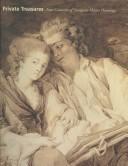| Listing 1 - 4 of 4 |
Sort by
|
Book

ISBN: 9781911300403 1911300407 Year: 2018 Publisher: London Paul Holberton Publishing
Abstract | Keywords | Export | Availability | Bookmark
 Loading...
Loading...Choose an application
- Reference Manager
- EndNote
- RefWorks (Direct export to RefWorks)
In terms of antiquarian fame, the Farnese Sarcophagus--elaborately carved with satyrs and maenads gathering grapes--may be the most important work of art in the Gardner collection, and perhaps of its type in America. A large, rectangular coffin of Pentelic marble, the Farnese Sarcophagus was exported from Athens to the area of Rome in the late Severan period, between c. 222 and 235 AD. The carving of the satyrs and maenads was especially suited to the artistic tastes of Mannerist and Baroque Rome, providing one of the most elegant examples of Greek imperial optic elongation to have survived from ancient times. 'Life, Death & Revelry' will offer a multi-disciplinary, multi-era look at this important monument. Published to accompany an exhibition at the Isabella Steward Gardner Museum, Boston, it will bring together archaeological analyses of the piece and its previous restorations, and numerous Renaissance prints and drawings depicting the sarcophagus during its time in Rome.
Sculpture --- sarcophagi [coffins] --- Roman sculpture styles --- Isabella Stewart Gardner Museum [Boston, Mass.] --- Sarcophagi, Greek --- Sculpture, Greek --- Art museums --- Isabella Stewart Gardner Museum --- Sarcophagi, Greek. --- Sculpture, Greek.


ISBN: 9780853319580 Year: 2007 Publisher: Aldershot Lund Humphries
Abstract | Keywords | Export | Availability | Bookmark
 Loading...
Loading...Choose an application
- Reference Manager
- EndNote
- RefWorks (Direct export to RefWorks)
Drawing --- anno 1500-1799 --- anno 1800-1999 --- Europe --- tekeningen --- privécollecties --- Europa --- drawing [image-making] --- Verenigde Staten, privé-collectie --- tekeningen. --- privécollecties. --- Europa.
Book

ISBN: 9781588396495 1588396495 Year: 2019 Publisher: New York, N.Y. The Metropolitan Museum of Art
Abstract | Keywords | Export | Availability | Bookmark
 Loading...
Loading...Choose an application
- Reference Manager
- EndNote
- RefWorks (Direct export to RefWorks)
The first comprehensive look at the origins and diffusion across Europe of the etched print during the late 15th and early 16th centuries. The etching of images on metal, originally used as a method for decorating armor, was first employed as a printmaking technique at the end of the 15th century. This in-depth study explores the origins of the etched print, its evolution from decorative technique to fine art, and its spread across Europe in the early Renaissance, leading to the professionalization of the field in the Netherlands in the 1550s. Beautifully illustrated, this book features the work of familiar Renaissance artists, including Albrecht Durer, Jan Gossart, Pieter Breughel the Elder, and Parmigianino, as well as lesser known practitioners, such as Daniel Hopfer and Lucas van Leyden, whose pioneering work paved the way for later printmakers like Rembrandt and Goya. The book also includes a clear and fascinating description of the etching process, as well as an investigation of how the medium allowed artists to create highly detailed prints that were more durable than engravings and more delicate than woodblocks. Exhibition: The Metropolitan Museum of Art, New York, USA (23.10.2019-19.01.2020) "'The Renaissance of Etching' is a groundbreaking study of the origins of the etched print. Initially used as a method for decorating armor, etching was reimagined as a printmaking technique at the end of the fifteenth century in Germany and spread rapidly across Europe. Unlike engraving and woodcut, which required great skill and years of training, the comparative ease of etching allowed a wide variety of artists to exploit the expanding market for prints. The early pioneers of the medium include some of the greatest artists of the Renaissance, such as Albrecht Dürer, Parmigianino, and Pieter Bruegel the Elder, who paved the way for future printmakers like Rembrandt, Goya, and many others in their wake. Remarkably, contemporary artists still use etching in much the same way as their predecessors did five hundred years ago. Richly illustrated and including a wealth of new information, 'The Renaissance of Etching' explores how artists in Germany, the Netherlands, Italy, and France developed the new medium of etching, and how it became one of the most versatile and enduring forms of printmaking." --
Gravure à l'eau-forte --- Etching, European --- Prints, European --- Catalogues d'exposition. --- Exhibitions. --- Graphic arts --- etchings [prints] --- anno 1400-1499 --- anno 1500-1599 --- Europe --- 762.2 --- 76 "15" --- 762.2 Etstechnieken: ets; vernis mou --- Etstechnieken: ets; vernis mou --- 76 "15" Grafische kunsten. Grafiek. Prentkunst--16e eeuw. Periode 1500-1599 --- Grafische kunsten. Grafiek. Prentkunst--16e eeuw. Periode 1500-1599 --- Exhibitions --- Gravure à l'eau-forte
Book

Year: 2007 Publisher: Milaan Federico Motta
Abstract | Keywords | Export | Availability | Bookmark
 Loading...
Loading...Choose an application
- Reference Manager
- EndNote
- RefWorks (Direct export to RefWorks)
| Listing 1 - 4 of 4 |
Sort by
|

 Search
Search Feedback
Feedback About UniCat
About UniCat  Help
Help News
News